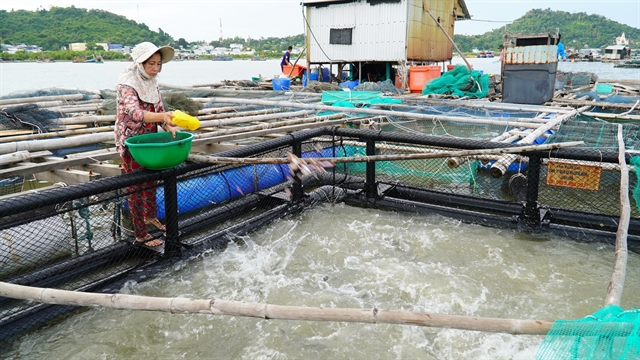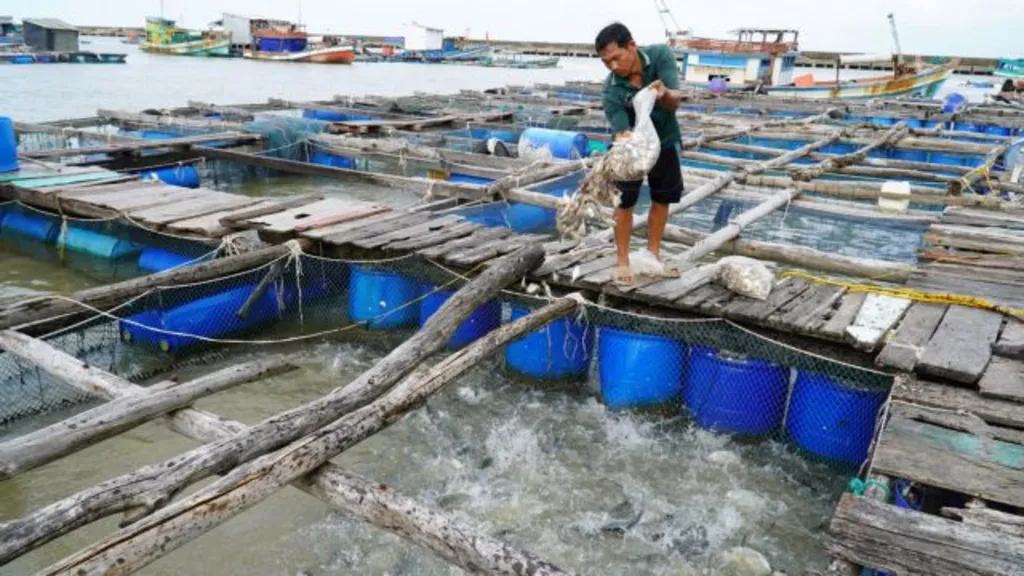 Society
Society

 |
| Floating cages in the sea for farming fish in Kiên Giang Province’s Kiên Hải District. —VNA/VNS Photo Văn Sĩ |
KIÊN GIANG — The southern province of Kiên Giang will restructure aquaculture and fishing to protect the environment and ensure they develop sustainably.
Lê Hữu Toàn, Director of the provincial Department of Agriculture and Rural Development, said large, concentrated aquaculture areas using advanced and environment-friendly breeding techniques would be developed.
The province would strengthen protection of aquatic species near shore and the fight against illegal, unreported and unregulated fishing (IUU) activities, he said.
It has large fishing grounds of around 63,000sq.km, 8,212 fishing boats, including 3,700 with a length of at least 15m for off-shore fishing.
It aims to reduce the number of near-shore fishing boats to protect aquatic resources and fishermen switch to other suitable jobs.
It has released seeds of aquatic species into rivers and lakes, and banned the catch of some of them during their reproduction season in recent years.
Last year it prohibited fishermen from catching bivalve mollusks such as blood cockles, yellow clams and ark clams near shore between July 1 and December 31 to protect and regenerate those species.
Kiên Giang, one of the Cửu Long (Mekong) Delta’s main fisheries provinces, aims to produce 800,000 tonnes from aquaculture and fishing this year, including 435,000 tonnes from the latter.
The output in the first two months of the year was 95,670 tonnes, or 12 per cent of the year’s target, worth VNĐ3.6 trillion (US$144 million), up 3.4 per cent year-on-year, according to the department.
The province has 148,000ha of aquaculture farms that raise shrimp, fishes and bivalve mollusks.
The aquaculture output alone in the first two months was 27,200 tonnes, an increase of 2 per cent. Shrimp accounted for 10,250 tonnes.
The province breeds shrimp under various models such as traditional and industrial farming and shrimp-rice farming.
Caged aquaculture
 |
| A farmer feeds marine fish bred in floating cages in Kiên Giang Province’s Kiên Hải District. – VNA/VNS Photo Văn Sĩ |
Kiên Giang is increasing the breeding of marine fish and other aquatic species in floating cages to capitalise on its great potential for marine aquaculture with its coastline of 200km, more than 100 river mouths and 143 islands.
It aims to develop marine aquaculture on an industrial scale while also protecting the environment and combining it with tourism.
The province has the largest number of floating cages in the delta: 3,837.
It is done mostly in Kiên Lương and Kiên Hải districts and Hà Tiên and Phú Quốc cities, with farmers breeding mostly high-value species such as cobia, grouper, yellow pomfret and pearl oysters.
The prices of marine fish have been high this year, giving farmers the confidence to increase investment in marine aquaculture.
Võ Thị Thắm in Kiên Hải District’s Hòn Tre Commune said her family is raising various marine fishes like cobia, grouper, seabass, and yellow pomfret in 40 floating cages this year.
They have installed high-density polyethylene (HDPE) floating cages, she said.
Last year the department assisted her family with breeding fish in HDPE cages on a trial basis, and they proved more efficient than traditional wooden ones, she said.
“Early this year the price of farmed fish is high, and I felt reassured and hope the prices are maintained until year-end.”
Her family harvested 35 tonnes of various fishes last year and earned VNĐ700 million ($28,000), she added.
The province encourages farmers to increase the use of HDPE floating cages as they are more resistant to strong waves and winds than traditional wooden ones.
The province targets having 4,000 floating cages, both HDPE and traditional wooden ones, by this year with an annual output of 4,400 tonnes, according to the department.
To meet the targets, the department plans to effectively adopt advanced breeding techniques and implement agricultural extension models from now to 2030.
It will prioritise high-tech breeding models that use HDPE floating cages and modern breeding facilities and solar power.
It will train farmers in preventing fish diseases and breeding regulations, and strictly manage breeding areas together with monitoring the water environment and enhancing disease forecast capacity.
Toàn said the province encourages breeders to develop linkages between various stakeholders in marine aquaculture, encourages farmers to breed high-value species and use industrial food to feed them.
Farmers now mostly use trash fish (usually marine fish with little or no market value as human food) to feed their stocks.
“The province is also increasingly calling on companies to invest in floating cages, supply brood stock for farmers, buy their output, and process and export their products.” — VNS